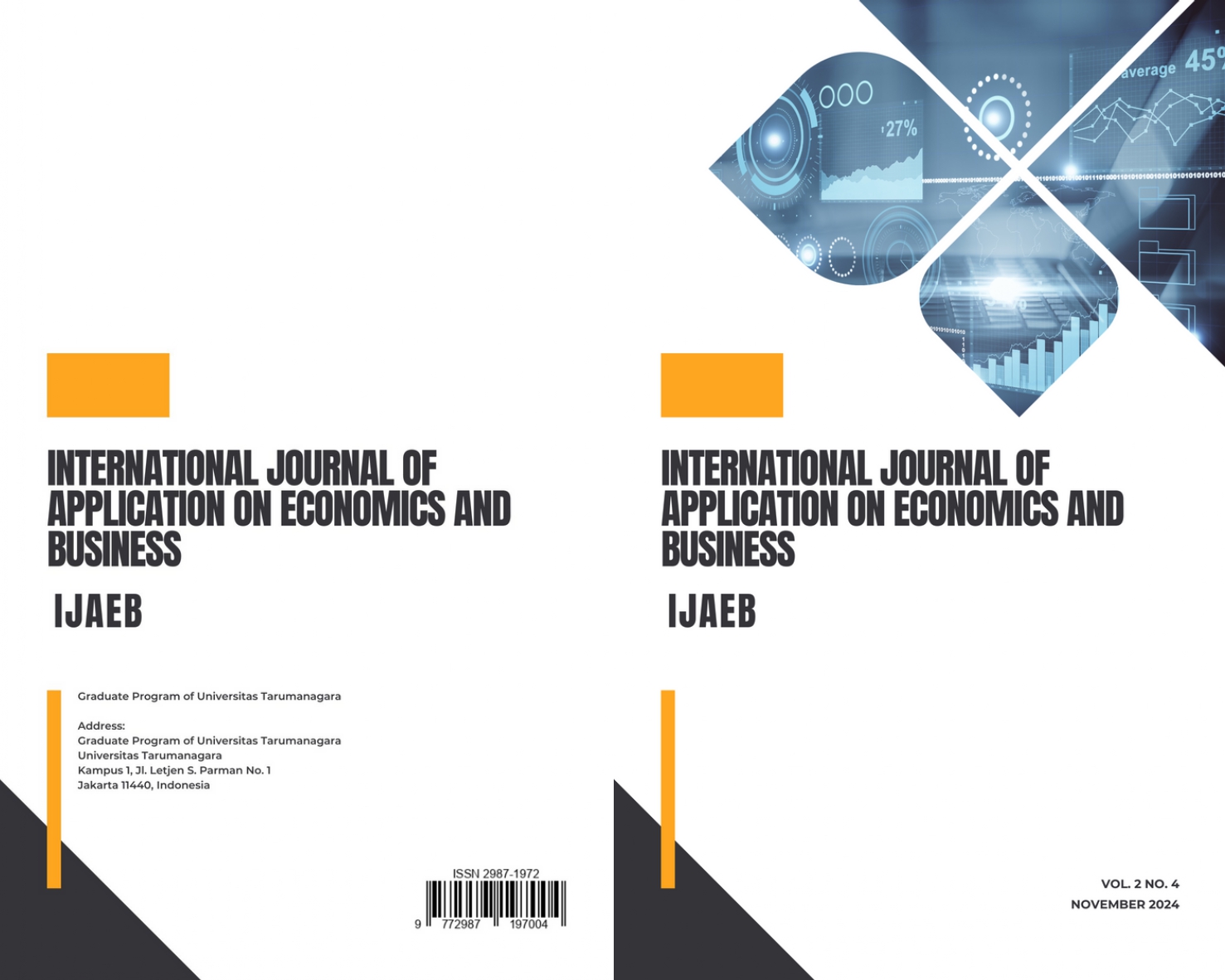PREDICTING REPURCHASE INTENTION WITH E-SATISFACTION AS A MEDIATOR ON E-COMMERCE SHOPEE
Main Article Content
Abstract
This study aims to examine the effect for Shopee (one of Indonesia’s e-commerce service) of web design that contains visual and user interface, information quality that dense, clear and relevant, as well as safe, on-time delivery services and an assortment of delivery services on repurchase intention with e-satisfaction as a mediating variable. Nowadays, problems often arise from consumer talk about web design, user interfaces that are not too familiar with everyday use. Data collection in this study uses non-probability sampling with range of the shopee (e-commerce) buyer in Jakarta only, with the type of that sample that may be a purposive sampling. The number of samples in this study were 223 respondents. This study uses Smart PLS-SEM version 4.0 to process data. The purpose of this research is to provide insight for future research and prove that it can increase customer satisfaction and increase repurchases in shopping.. Using several leading theories and conceptual variables, the variables that become this study are more valid and can be considered for future research. and linking between important elements, namely information quality, delivery service, e-satisfaction, web desig, information quality with repurchase intention. Based on the results of this study indicate that web design, information quality, and delivery service can significantly and positively influence repurchase intention mediated by e-satisfaction.
Article Details

This work is licensed under a Creative Commons Attribution-NonCommercial-ShareAlike 4.0 International License.
This journal provides immediate open access to its content on the principle that making research freely available to the public supports a greater global exchange of knowledge.
IJAEB by Graduate Program of Universitas Tarumanagara is licensed under a Creative Commons Attribution-NonCommercial-ShareAlike 4.0 International License.. Permissions beyond the scope of this license may be available at https://journal.untar.ac.id/index.php/ijaeb
References
Cheng, J.H., Lin, L.W., Lee, L.C. (2019). Influence of ambidextrous governance mechanisms and risk management on repurchase intention in social commerce. Internet Research, Vol 29 No. 6, 2019.
Cosar, C., Panyi, K., & Varga, A. (2017). Try not to be late! the importance of delivery service in online shopping. 8(2), 177–192.
Elim, C. N., & Santoso, T. (2022). Pengaruh website characteristic dan delivery service quality terhadap repurchase intention melalui customer satisfaction pada pengguna Shopee selama masa pandemi covid-19. Agoda, 10(1).
Flavian, C., Gurrea, R., & Orus, C. (2009). Web design: a key factor for the website success. In Journal of Systems and Information Technology (Vol. 11, Issue 2, pp. 168–184). https://doi.org/10.1108/13287260910955129
Garett, R., Chiu, J., Zhang, L., & Young, S. D. (2016). A literature review: website design and user engagement. Online J Commun Media Technol, 6(3), 1–14.
Guo, X., Ling, K.C., & Liu, M. (2012). Evaluating factors influencing consumer satisfaction toward online shopping in china. Asian Social Science; Vol. 8, No. 13; 2012
Hair, J. F., M. Hult, G. T., M. Ringle, C., & Sarstedt, M. (2022). A primer on partial least squares structural equation modeling.
Howard, G., Lubbe, S., & Klopper, R. (2011). The impact of information quality on information research. Alternation Special Edition 4, 288–305. https://www.researchgate.net/publication/268025893
Mala, J., & Cerna, L. (2012). Information quality, its dimension and the basic criteria for assessing information quality. 20, 86–93. https://doi.org/10.2478/v10186-012-0015-4
Marcolio, & Ruslim, T. S. (2023). Study of influencing factors online repurchase intention of bukalapak consumers in jabodetabek. Www.Ijbmm.Com International Journal of Business Marketing and Management, 8(4), 122–132. www.ijbmm.com
Meida, T. A., & Yusran, H. L. (2022). Pengaruh information quality dan brand equity melalui perceived value terhadap customer satisfaction pada pengguna aplikasi Go Food di masa covid-19. International Journal of Demos, 4(1), 12–26.
Miao, M., Jalees, T., Zaman, S. I., Khan, S., Hanif, N. ul A., & Javed, M. K. (2022). The influence of e-customer satisfaction, e-trust and perceived value on consumer’s repurchase intention in B2C e-commerce segment. Asia Pacific Journal of Marketing and Logistics, 34(10), 2184–2206. https://doi.org/10.1108/APJML-03-2021-0221
Quan, N. H., Chi, N. T. K., Nhung, D. T. H., Ngan, N. T. K., & Phong, L. T. (2020). The influence of website brand equity, e-brand experience on e-loyalty: The mediating role of e-satisfaction. Management Science Letters, 10(1), 63–76. https://doi.org/10.5267/j.msl.2019.8.015
Ramadhan, G., & Soesanto, H. (2017). Analisis pengaruh kualitas informasi dan pelayanan website dalam meningkatkan minat beli ulang mahasiswa universitas diponegoro pada situs elevenia.co.id dengan menggunakan kepuasan konsumen sebagai variabel mediasi. DIPONEGORO JOURNAL OF MANAGEMENT, 6(4), 1–12. http://ejournal-s1.undip.ac.id/index.php/dbr
Rawung, T. P., Kindangen, P., & Tumewu, F. J. (2022). The impact of web design, customer service, security, and fullfillment towards customer satisfaction of online shoppers (case study: sam ratulangi university student). Jurnal EMBA, 10(4), 1070–1078.
Ridho, F., Hartono, S., & Istiqomah. (2021). Easy, quality of service, and timeliness of delivery to customer satisfaction. Almana : Jurnal Manajemen Dan Bisnis, 5(2), 184–191. https://doi.org/10.36555/almana.v5i2.1552
Riliana, E. (2021). Pengaruh e-satisfaction, e-trust, dan perceived value terhadap repurchase intention pada e-commerce.
Risdiyanto, A. (2014). Pengaruh informasi, kualitas sistem, dan kualitas layanan terhadap kepuasan pengguna pada sistem informasi klinik.
Sekaran, U., & Bougie, R. (2020). Research Methods for business.
Tata, V.S., Prashar, S., & Parsad, C. (2020). Examining the influence of satisfaction and regret on online shoppers’ post-purchase behaviour. Benchmarking An International Journal.
Widodo, D. Y. P., & Prasetyani, H. (2022). Pengunaan Shopee sebagai media promosi untuk meningkatkan daya jual produk sebagai narahubung sosial marketing. Journal of Systems, Information Technology, and Electronics Engineering, 2(2), 12–17. https://doi.org/10.31331/jsitee.v1i1.kodeartikel
Wilson, N., Keni, K., & Tan, P. H. P. (2019). The effect of website design quality and service quality on repurchase intention in the e-commerce industry: a cross-continental analysis. Gadjah Mada International Journal of Business, 21(2), 187–222



